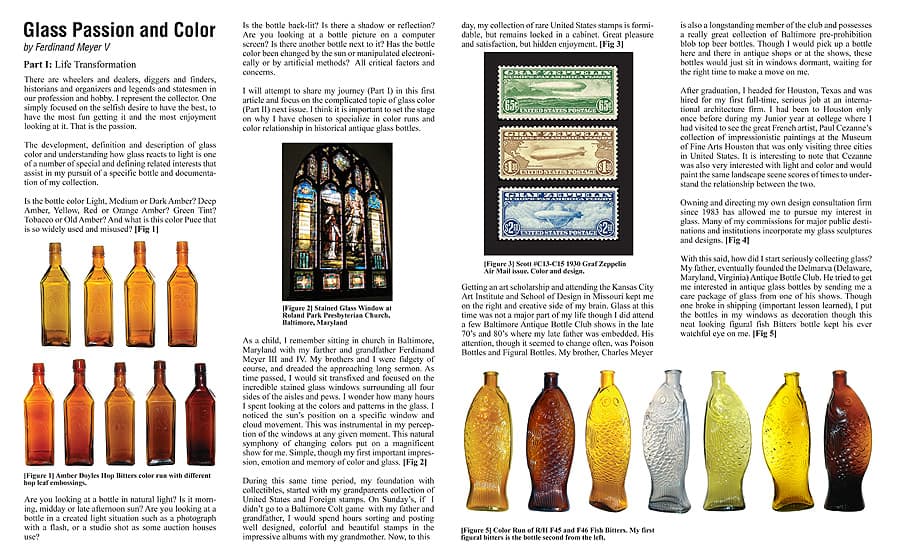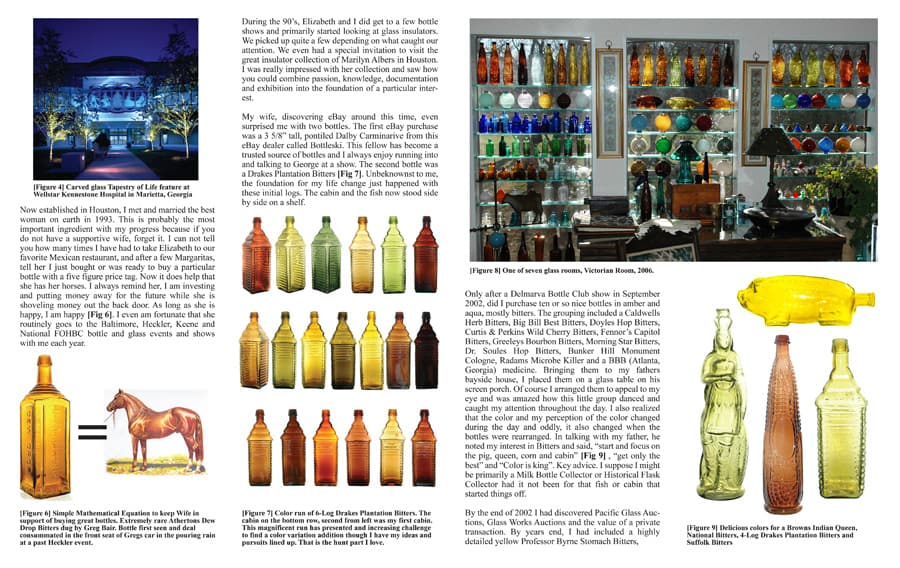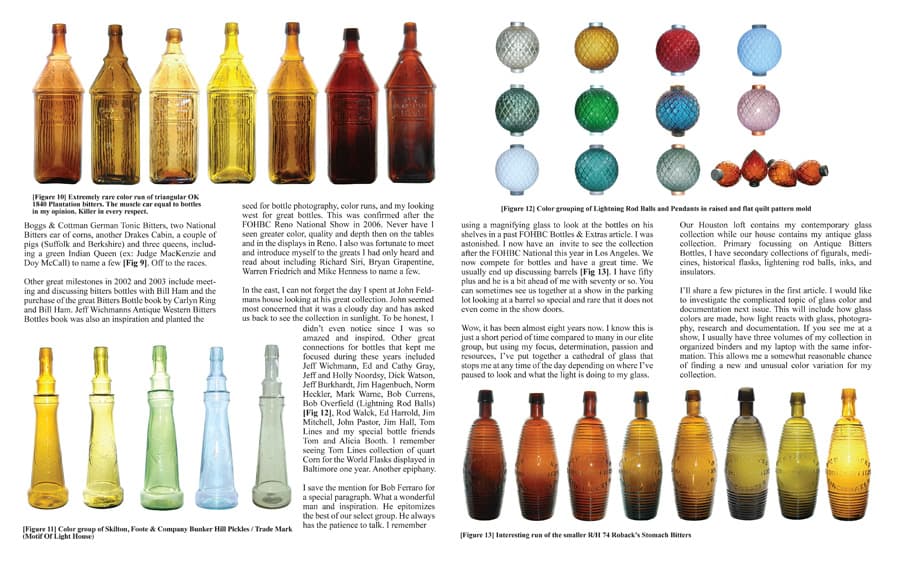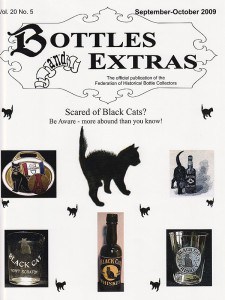*as reprinted from The Federation of Historical Bottle Collectors (FOHBC) Bottles & Extra Magazine. September-October 2009
Glass Passion and Color
Part I: Life Transformation
Read: Glass Passion and Color Part II : Exploration and Color
by Ferdinand Meyer V
08 April 2011
There are wheelers and dealers, diggers and finders, historians and organizers and legends and statesmen in our profession and hobby. I represent the collector. One simply focused on the selfish desire to have the best, to have the most fun getting it and the most enjoyment looking at it. That is the passion.
The development, definition and description of glass color and understanding how glass reacts to light is one of a number of special and defining related interests that assist in my pursuit of a specific bottle and documentation of my collection.
Is the bottle color Light, Medium or Dark Amber? Deep Amber, Yellow, Red or Orange Amber? Green Tint? Tobacco or Old Amber? And what is this color Puce that is so widely used and misused? Are you looking at a bottle in natural light? Is it morning, midday or late afternoon sun? Are you looking at a bottle in a created light situation such as a photograph with a flash, or a studio shot as some auction houses use? Is the bottle back-lit? Is there a shadow or reflection? Are you looking at a bottle picture on a computer screen? Is there another bottle next to it? Has the bottle color been changed by the sun or manipulated electronically or by artificial methods? All critical factors and concerns.
I will attempt to share my journey (Part I) in this first article and focus on the complicated topic of glass color (Part II) next issue. I think it is important to set the stage on why I have chosen to specialize in color runs and color relationship in historical antique glass bottles.
As a child, I remember sitting in church in Baltimore, Maryland with my farther and grandfather Ferdinand Meyer III and IV. My brothers and I were fidgety of course, and dreaded the approaching long sermon. As time passed, I would sit transfixed and focused on the incredible stained glass windows surrounding all four sides of the aisles and pews. I wonder how many hours I spent looking at the colors and patterns in the glass. I noticed the sun’s position on a specific window and cloud movement. This was instrumental in my perception of the windows at any given moment. This natural symphony of changing colors put on a magnificent show for me. Simple, though my first important impression, emotion and memory of color and glass.
During this same time period, my foundation with collectibles, started with my grandparents collection of United States and Foreign stamps. On Sunday’s, if I didn’t go to a Baltimore Colt game with my father and grandfather, I would spend hours sorting and posting well designed, colorful and beautiful stamps in the impressive albums with my grandmother. Now, to this day, my collection of rare United States stamps is formidable, but remains locked in a cabinet. Great pleasure and satisfaction, but hidden enjoyment.
Getting an art scholarship and attending the Kansas City Art Institute and School of Design in Missouri kept me on the right and creative side of my brain. Glass at this time was not a major part of my life though I did attend a few Baltimore Antique Bottle Club shows in the late 70’s and 80’s where my late father was embedded. His attention, though it seemed to change often, was Poison Bottles and Figural Bottles. My brother, Charles Meyer is also a longstanding member of the club and possesses a really great collection of Baltimore pre-prohibition blob top beer bottles. Though I would pick up a bottle here and there in antique shops or at the shows, these bottles would just sit in windows dormant, waiting for the right time to make a move on me.
After graduation, I headed for Houston, Texas and was hired for my first full-time, serious job at an international architecture firm. I had been to Houston only once before during my Junior year at college where I had visited to see the great French artist, Paul Cezanne’s collection of impressionistic paintings at the Museum of Fine Arts Houston that was only visiting three cities in United States. It is interesting to note that Cezanne was also very interested with light and color and would paint the same landscape scene scores of times to understand the relationship between the two. Owning and directing my own design consultation firm since 1983 has allowed me to pursue my interest in glass. Many of my commissions for major public destinations and institutions incorporate my glass sculptures and designs.
With this said, how did I start seriously collecting glass? My father, eventually founded the Delmarva (Delaware, Maryland, Virginia) Antique Bottle Club. He tried to get me interested in antique glass bottles by sending me a care package of glass from one of his shows. Though one broke in shipping (important lesson learned), I put the bottles in my windows as decoration though this neat looking figural fish Bitters bottle kept his ever watchful eye on me.
Now established in Houston, I met and married the best woman on earth in 1993. This is probably the most important ingredient with my progress because if you do not have a supportive wife, forget it. I can not tell you how many times I have had to take Elizabeth to our favorite Mexican restaurant, and after a few Margaritas, tell her I just bought or was ready to buy a particular bottle with a five figure price tag. Now it does help that she has her horses. I always remind her, I am investing and putting money away for the future while she is shoveling money out the back door. As long as she is happy, I am happy. I even am fortunate that she routinely goes to the Baltimore, Heckler, Keene and National FOHBC bottle and glass events and shows with me each year.
During the 90’s, Elizabeth and I did get to a few bottle shows and primarily started looking at glass insulators. We picked up quite a few depending on what caught our attention. We even had a special invitation to visit the great insulator collection of Marilyn Albers in Houston. I was really impressed with her collection and saw how you could combine passion, knowledge, documentation and exhibition into the foundation of a particular interest.
My wife, discovering eBay around this time, even surprised me with two bottles. The first eBay purchase was a 3 5/8” tall, pontiled Dalby Carminarive from this eBay dealer called Bottleski. This fellow has become a trusted source of bottles and I always enjoy running into and talking to George at a show. The second bottle was a Drakes Plantation Bitters. Unbeknownst to me, the foundation for my life change just happened with these initial logs. The cabin and the fish now stood side by side on a shelf.
Only after a Delmarva Bottle Club show in September 2002, did I purchase ten or so nice bottles in amber and aqua, mostly bitters. The grouping included a Caldwells Herb Bitters, Big Bill Best Bitters, Doyles Hop Bitters, Curtis & Perkins Wild Cherry Bitters, Fennor’s Capitol Bitters, Greeleys Bourbon Bitters, Morning Star Bitters, Dr. Soules Hop Bitters, Bunker Hill Monument Cologne, Radams Microbe Killer and a BBB (Atlanta, Georgia) medicine. Bringing them to my fathers bayside house, I placed them on a glass table on his screen porch. Of course I arranged them to appeal to my eye and was amazed how this little group danced and caught my attention throughout the day. I also realized that the color and my perception of the color changed during the day and oddly, it also changed when the bottles were rearranged. In talking with my father, he noted my interest in Bitters and said, “start and focus on the pig, queen, corn and cabin” [Fig 9] , “get only the best” and “Color is king”. Key advice. I suppose I might be primarily a Milk Bottle Collector or Historical Flask Collector had it not been for that fish or cabin that started things off.
By the end of 2002 I had discovered Pacific Glass Auctions, Glass Works Auctions and the value of a private transaction. By years end, I had included a highly detailed yellow Professor Byrne Stomach Bitters, Boggs & Cottman German Tonic Bitters, two National Bitters ear of corns, another Drakes Cabin, a couple of pigs (Suffolk and Berkshire) and three queens, including a green Indian Queen (ex: Judge MacKenzie and Doy McCall) to name a few. Off to the races.
Other great milestones in 2002 and 2003 include meeting and discussing bitters bottles with Bill Ham and the purchase of the great Bitters Bottle book by Carlyn Ring and Bill Ham. Jeff Wichmanns Antique Western Bitters Bottles book was also an inspiration and planted the seed for bottle photography, color runs, and my looking west for great bottles. This was confirmed after the FOHBC Reno National Show in 2006. Never have I seen greater color, quality and depth then on the tables and in the displays in Reno. I also was fortunate to meet and introduce myself to the greats I had only heard and read about including Richard Siri, Bryan Grapentine, Warren Friedrich and Mike Henness to name a few.
In the east, I can not forget the day I spent at John Feldmans house looking at his great collection. John seemed most concerned that it was a cloudy day and has asked us back to see the collection in sunlight. To be honest, didn’t even notice since I was so amazed and inspired. Other great connections for bottles that kept me focused during these years included Jeff Wichmann, Ed and Cathy Gray, Jeff and Holly Noordsy, Dick Watson, Jeff Burkhardt, Jim Hagenbuch, Norm Heckler, Mark Warne, Bob Currens, Bob Overfield (Lightning Rod Balls), Rod Walck, Ed Harrold, Jim Mitchell, John Pastor, Jim Hall, Tom Lines and my special bottle friends Tom and Alicia Booth. I remember seeing Tom Lines collection of quart Corn for the World Flasks displayed in Baltimore one year. Another epiphany.
I save the mention for Bob Ferraro for a special paragraph. What a wonderful man and inspiration. He epitomizes the best of our select group. He always has the patience to talk. I remember using a magnifying glass to look at the bottles on his shelves in a past FOHBC Bottles & Extras article. I was astonished. I now have an invite to see the collection after the FOHBC National this year in Los Angeles. We now compete for bottles and have a great time. We usually end up discussing barrels. I have fifty plus and he is a bit ahead of me with seventy or so. You can sometimes see us together at a show in the parking lot looking at a barrel so special and rare that it does not even come in the show doors.
Wow, it has been almost eight years now. I know this is just a short period of time compared to many in our elite group, but using my focus, determination, passion and resources, I’ve put together a cathedral of glass that stops me at any time of the day depending on where I’ve paused to look and what the light is doing to my glass. Our Houston loft contains my contemporary glass collection while our house contains my antique glass collection. Primary focusing on Antique Bitters Bottles, I have secondary collections of figurals, medicines, historical flasks, lightening rod balls, inks, and insulators.
I’ll share a few pictures in the first article. I would like to investigate the complicated topic of glass color and documentation next issue. This will include how glass colors are made, how light reacts with glass, photography, research and documentation. If you see me at a show, I usually have three volumes of my collection in organized binders and my laptop with the same information. This allows me a somewhat reasonable chance of finding a new and unusual color variation for my collection.










